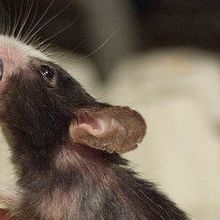DNA damage response

Mitochondria May Have Been Wrongly Accused in DNA Damage
Shelby Bradford, PhD | Jul 11, 2024 | 4 min read
Reactive oxygen species cause mutations to DNA bases that can lead to cancer, but the long-blamed mitochondria could have been wrongfully charged.

An Immune Mechanism Maintains Memory
Shelby Bradford, PhD | Jun 10, 2024 | 4 min read
A receptor that recognizes DNA fragments formed during learning is necessary for proper memory formation.

How Plants Protect Their DNA in Space
Deanna MacNeil, PhD | Jan 24, 2024 | 4 min read
Dorothy Shippen and Borja Barbero Barcenilla investigated how spaceflight affects telomeres of Arabidopsis seedlings grown on the International Space Station.

Infographic: DNA Damage Viewed with Unprecedented Clarity
Amanda Heidt | Aug 15, 2022 | 2 min read
A new genetic sensor called PRISM makes use of a host cell’s DNA replication machinery to trigger fluorescence in neurons with damaged DNA.

DNA Damage Viewed with Unprecedented Clarity
Amanda Heidt | Aug 15, 2022 | 3 min read
A new tool called PRISM draws on virus-host interactions and a DNA repair pathway to help researchers visualize how cellular stress may contribute to neurodegenerative disease.

Bridging Disciplines to Study CRISPR-Induced Chromosome Destabilization
Aparna Nathan, PhD | Apr 8, 2022 | 4 min read
A collaboration between friends led to a cautionary finding about CRISPR’s effect on cells.

Bacteria Set Off Viral “Bombs” Inside Neighbors
Natalia Mesa, PhD | Mar 7, 2022 | 2 min read
A study finds some E. coli can deploy a chemical called colibactin to reawaken long-dormant viruses inside bacteria, causing destruction.

DNA Damage Makes Zebrafish Sleepy
Sophie Fessl, PhD | Nov 18, 2021 | 4 min read
Buildup of a DNA-repair protein in brain cells spurs shut-eye in the fish, a study finds, and similar results in mice suggest the mechanism is widespread in animals.

Stress-Induced Chromosome Changes Protect Flies’ Aging Brains
Lisa Winter | Dec 1, 2020 | 2 min read
Brain cells in older Drosophila tend to have more than two complete sets of chromosomes, and that polyploidy most likely has a protective function, a study shows.

PARP Inhibitors Are Improving the Outlook of Hard-to-Treat Cancers
Vicki Brower | Apr 1, 2018 | 9 min read
With three recent FDA approvals, and a number of Phase 3 trials ongoing, the drugs are seeing a surge in interest.

Alcohol Damages Mouse DNA
Jef Akst | Jan 3, 2018 | 1 min read
A byproduct of alcohol consumption causes mutations in the DNA of mouse blood stem cells, and some of the breaks are not repaired.

Noncoding RNA Helps Cells Recover from DNA Damage
Diana Kwon | May 1, 2017 | 2 min read
Scientists discover transcripts from the same gene that can express both proteins and noncoding RNA.

How We Age
The Scientist | Mar 1, 2015 | 10+ min read
From DNA damage to cellular miscommunication, aging is a mysterious and multifarious process.

Wrangling Retrotransposons
Andrei Seluanov, Michael Van Meter, and Vera Gorbunova | Mar 1, 2015 | 8 min read
These mobile genetic elements can wreak havoc on the genome. Researchers are now trying to understand how such activity contributes to the aging process.

DNA Damage Scout
Andrew P. Han | Feb 11, 2014 | 4 min read
Researchers are beginning to appreciate a role for RNA polymerase beyond gene transcription.

Brain Activity Breaks DNA
Sabrina Richards | Mar 24, 2013 | 3 min read
Researchers find that temporary double-stranded DNA breaks commonly result from normal neuron activation—but expression of an Alzheimer’s-linked protein increases the damage.
DNA, Contortionist
Kerry Grens | Aug 1, 2012 | 2 min read
The DNA forms known as G-quadruplexes are finally discovered in human cells.
Daniel Durocher: Change is Good
Kerry Grens | Jul 1, 2012 | 3 min read
Senior Investigator, Samuel Lunenfeld Research Institute, Toronto, Ontario, Canada. Age 40
